Students can go through AP State Board 8th Class Physical Science Notes Chapter 6 Sound to understand and remember the concept easily.
AP State Board Syllabus 8th Class Physical Science Notes Chapter 6 Sound
→ The vibrating body produces sound.
→ Human beings are able to produce sound with the help of vocal cords.
→ Sound travel through solids, liquids, and gases.
→ The material through which sound travels is called a medium.
→ Sound cannot travel through a vacuum.
→ The vibration of the eardrum caused by the sound produced by a vibrating body gives us a sense of hearing.
→ The loudness or feebleness of a sound is determined by the amplitude of vibration.
→ The intensity of sound is measured in decibels (dB).
→ Pitch or shrillness are determined by frequency.
→ The number of vibrations per second is called frequency.
→ Normal sounds consist of mixed frequencies.
→ The hearing limit of sounds by human beings is called audible range.
![]()
→ Sounds pleasant to listen to are called music and unpleasant to listen to are called noise.
→ Excessive or unwanted sounds lead to noise pollution. It may cause health problems for human beings.
→ Attempts should be made to minimize noise pollution.
→ Plantation on the roadside and elsewhere can reduce noise pollution.
→ Vibration: The to ánd fr motion of o body from Its mean position is known as vibration
→ Vocal cords: The two muscular ligaments at the end of the windpipe called vocal cords
→ Medium: The substance which allows the passage of sound is called medium
→ Vacuum: Condition of no medium or without medium
→ Eardrum: The thin membrane at the end of the auditory canal.
→ Loudness: Loudness or softness of sound depends on upoñ’omplitude. Loud sounds are having greater amplitude
→ Feeble: Sounds of low amplitude
→ Amplitude: The maximum displacement of the vibrating body from ¡ts mean position is coiled amplitude.
→ Decibel: Decibel is the unit for measuring the intensity of sound
![]()
→ Pitch (Shnllness): The shrillness of a sound known as pitch (or) Sound of higher frequency produce shrillness
→ Frequency: The number of vibrations per second is called frequency.
→ Noise: The sounds which are not pleasant to hear are coiled noises.
→ Music: The sounds which pleasant to hear are called music.
→ Audible range: The hearing limit of sounds by human beings ¡s called audible range.

→ Alexarnkr Graham Bell (1847 – 1922):
- He was an eminent scientist, inventor, engineer, and innovator who is credited with inventing the first practical telephone.
- Bell’s other inventions are including groundbreaking work in optical telecommunications, hydrofoils, and aeronautics.
- In 1888, Bell became one of the founding members of the National Geographic Society.